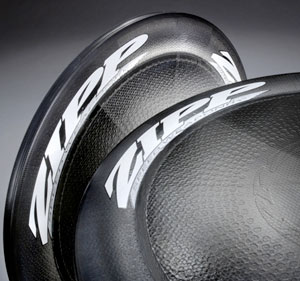SRAM’s ’08 Tri Offerings: An Analysis
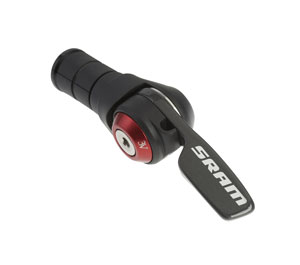
Pete Coulson and I are both North County San Diegans. I’ve known him for quite a while. Famous for being the worse half of Michellie Jones, Coulson and I have long shared a common interest: bike tech. As a world champion masters track athlete himself, he knows his gear inside and out, and takes a central role in helping set up Michellie’s bikes, with a mission to seek out what's fastest for MJ and for himself.
Pete and I are in almost constant contact, trying to trump the other by discovering new gear that hits the market, then giving an initial assessment. (Today, he had something in prototype form from one of Michellie’s sponsors that he simply couldn’t let out. "I…. I just can’t say," he told he, biting his lip. "I just got a call from Europe about how delicate keeping this secret is."
My reply? "Fine. Whatever, dude. Don’t tell me. See if I care." Followed seconds later by: "OK, c’mon, break me off a little somethin'!"
Investigative journalism at its most raw.
Anyway, Pete and I were in syncopation when we started looking at this new road group from SRAM a couple of years back. Good looking stuff, that Force was. Then came Red. PowerDome cassette. The short throw for the road shifters. The adjustable lever reach. The light action of the bar end shifters. And all that carbon. Impressive. But that wasn’t what drove Michelle and Pete to move to SRAM for sponsorship.
"SRAM is the first component company that has taken an interest in triathlon," Coulson says. "They're not just buying athletes and giving them product. They're at races, with the athletes, talking with them about product development."
Additionally, they supply Jones, among others, with real prototypes. That’s something Shimano does for its pro roadies, but typically their triathletes simply ride the coattails of that testing. "I have stuff now that I don’t know will ever go to market."
Just look at the list of pros they sponsor beyond the first guinea pigs of Jones and German Normann Stadler. They now have Chris Lieto, Torbjorn Sindballe, Samantha McGlone, Desiree Ficker, Jordan Rapp, Stephen Bayliss, Bella Comerford, David Thompson, Tim Don and Brad Kahlefeldt. Not a bad representation, and certainly a fair bit more than I can name off the top of my head who're sponsored by other brands.
Point is, SRAM is visibly making an effort to address the tri market, and is using its athletes to very rapidly develop and progress its product line. After all, it was less than two between the debut of Force to the introduction of Red. "When MJ first saw SRAM, it was just Force, and it was nice, nice enough for us to opt to work with them," Coulson says. "When Red came out, we were blown away.
"They don’t sit around on the same group for years," Coulson adds. "The other two companies' bar end shifters have been out for 20 years, but with SRAM, you seem to see new stuff from them every year."
For 2008, they've made some additions to their triathlon/time trial segment. Sure, they debuted a revamp of the mid-tier Force and the $919 entry-level Rival groupsets, bringing them in functional and cosmetic line with the top-line Red groupset. We'll have a look at that later. But for now, we’ll focus on their TT offerings, which are all expected to hit shelves this Fall.
For a brand that has exploded with glitz on the scene, the tri offerings are a contrast, focusing instead on value. SRAM marketing manager Michael Zellmann visited with [Slowtwitch publisher] Dan Empfield and I in Agoura Hills just before the Tour of Georgia to show us the new goods, as well as turn the cranks over the Santa Monica Mountains. Here is what we saw.
SRAM 500 Shifters
All the function, lighter weight, less stress on the budget. SRAM brings their technology to the masses, subbing the brand's existing carbon shift lever for a gloss black painted aluminum one. It has the same action and throw, and for a second, I wasn’t sure it was alloy and had to look closely to see there was no carbon weave there.
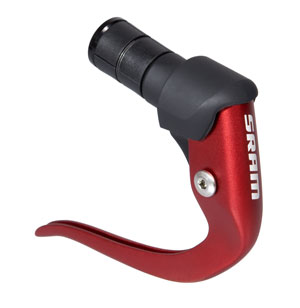
The shifter internals are super easy. This version also features a three-position stop; an internal "coin" can be flipped and rotated to tune the cable release to your liking. All that, at a listed 154 grams.
Considering the claimed weight for the carbon version of their shifter is 138 grams, the price is about $190 and the function and design are exactly the same… well, I'd rather put a bit more coin in my pocket in lieu of 17 grams. I'll just skip that slice of cake tonight. We all have to make sacrifices.
SRAM 500 Aero Brake Levers
Same story: a red anodized aluminum blade is used in place of carbon, resulting in a $108 set, versus a $120 for the carbon version. And all the same functional features are there, most importantly a strong return spring.
For once I'd be interested in swapping carbon, in exchange for this satin red levers. At 115 grams, just 16 grams heavier than their carbon brother, with every bit the function and aero shape as their predecessor, I'd be hard pressed to call it downgrading. Of course, most of my bikes have red accents, so its merely for vanity sake. But I’d be certain I wasn’t making any functional compromises. In fact, I have a hunch the anodizing is just a bit grippier, especially when grabbing handfuls of brake on a downhill with wet hands from rains or just having come out of the swim.
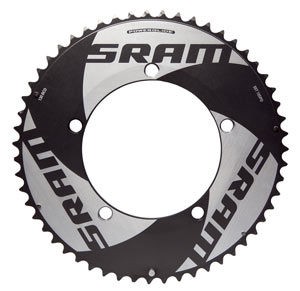
Jones was one of the guinea pigs for the 500 series, and said they were up to the task. "They’re every bit as good as the top end stuff," Coulson says. "If you look at the weight diff, it's not great. As high-end as all of SRAM's components are, it's filtering down."
TT Chainrings
SRAM did manage one truly new product for this year: a time trial/triathlon chainring. Aside from the bold branding, they're not flashy, and don't need to be. They consist of a flat aero profile, nice ramps and pins on an anodized set of rings (a 42-tooth inner and either a 54- or 55-tooth outer ring).
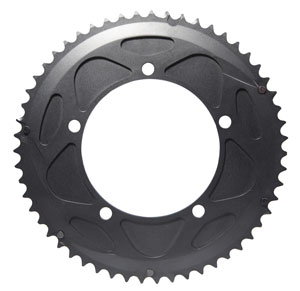
Looking at the inboard portion of the big blade, SRAM notes they left some vertical material to add strength. Maybe they're thinking about their Astana guys during a prologue, or Torbjorn, as I don’t think I or many other age groupers could put a lick of flex into these chainblades. The jury is still out as to whether a solid ring adds any appreciable aerodynamic effect, but hey, they look good. Prices and weights are yet to be determined.
Integrated S-bend Extensions
One last debut is a pretty small piece of the puzzle, but was one of my favorite products at Interbike last year: the integrated s-bend extension. The collaboration between SRAM and its recent acquisition of Zipp saw the birth of their first joint product, the SRAM shifter-compatible s-bend extension. The idea is to get rid of the heavy wedge mechanism used to affix these shifters into aerobar extensions. No, this isn't the first time this has been done. Easton's aerobars have had Shimano shifter-ready extensions for years. But this is the first time a modular extension has had a SRAM mount on which the user can install the shifter without the use of the heavy wedge hardware.
While its may seem an insignificant part, I'm a big fan of it. Not just because the integration eliminates weight, but because the direct mount will eliminate the inner plug, a piece capable of flexing, arguably granting the rider crisper shifting. I haven’t tested this, it's just a theory to this point. But just think about the bar-end shifts that you have to lean a little into because the lever flexes the inner plug. Less time fussing with a shift means more time focused while turning the cranks. Will they come out with a traditional ski-tip bend integrated? Let's hope so.


